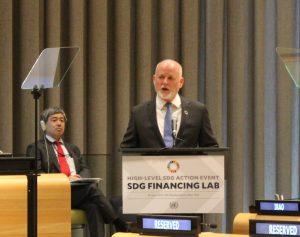As delivered
Opening remarks of H.E. Peter Thomson, President of the UN General Assembly at High Level SDG Action Event “SDG Financing Lab”
18 April 2017
Your Excellency, Ms. Amina Mohammed, Deputy Secretary-General of the United Nations,
Mr. Mahmoud Mohieldin, World Bank Group Senior Vice-President for the 2030 Development Agenda, United Nations Relations, and Partnerships,
Excellencies,
Distinguished guests,
Ladies and Gentlemen,
Welcome all to today’s High-Level event. This ‘SDG Financing Lab’ builds on a series of high-level events my office has convened during the 71st session, all of which aim to drive global action to implement the 2030 Agenda for Sustainable Development.
Few issues can be more central to the implementation effort than mobilizing the resources needed to support the world’s long-term sustainable development objectives.
Estimates suggest that financing the Sustainable Development Goals will require annual investments of around US$6 trillion, or US$90 trillion over 15 years.
While these sums may seem enormous, and the complexity of reforms needed to mobilize these funds may seem prohibitive, the fact is the cost of inaction will ultimately be far greater.
It is no exaggeration to say that the costs of inaction might include putting at risk the future of humanity’s place on this planet.
An exponential transformation in the global financial system will be required if we are to achieve the SDGs. As the Addis Ababa Action Agenda recognizes, we must tap into all sources of funding.
We are called upon to promote global awareness of the opportunities this exponential transformation presents for economic growth, for social development, for climate action, and for environmental protection.
We are at a time when we must foment a global conversation bringing all stakeholders together to discuss how we can mobilize the right mix of resources to achieve the SDGs.
This includes a discussion on what sources of financing are most effective to reach each goal, given each country’s context, and the different financial instruments available.
It includes what steps must be taken to align financial markets and investment patterns with the Sustainable Development Agenda; and what approaches must be pursued, to create an enabling environment at all levels for financing sustainable development.
It is for this vital conversation between us all that we have convened today’s event. We have provided a platform here at the United Nations today for those who can speak up in sharing their experiences and perspectives to help identify strategies for changing the financial system to become greener and more sustainable.
A key feature of today’s SDG Financing Lab is the participation of private sector actors. And there is a seminal reason for this.
The private sector serves as the custodian of the largest pools of the world’s resources, and the main engine driving entrepreneurship and innovation around the world.
It is therefore vital that the private sector is brought in as a key partner in our discussions on how to mobilize the investments that are needed to achieve the SDGs.
We must distinguish between the various sources of capital and asset classes that they represent, and recognize their varying spheres of operation and influence – from multinational corporations through to grassroots small-holder farmers.
Indeed, for example, institutional investors have vast pools of capital managed by insurance companies, pension funds, sovereign wealth funds, and philanthropic organisations. In the OECD alone these are valued at over US$80 trillion.
Shifting the investment behaviour of just this category of private sector actors has the potential to transform our global efforts to establish sustainable financial systems promoting long-term investments, fostering social inclusion and environmental stewardship, and generating economic growth.
This is why we are fortunate to be joined today in our discussions by one of the world’s largest insurers – Aviva.
Aviva alone has more than US$500 billion invested globally. It is already working to strengthen the guidelines, benchmarks, and reporting criteria for investments so that they are either aligned with, or contribute to the implementation of the SDGs.
Such shifts are incrementally being made by institutional investors across the world.
Over the last two to three years, institutional investors have divested more than US$2.3 trillion from fossil fuel assets.
And Sovereign Wealth Funds are using their investments as leverage to change corporate short-termism in company decision-making in order to bring greater focus to sustainability.
The challenge for the international community is how we can catalyse this shift, by creating the right incentives and enabling environments so that progressively more private sector actors orient their businesses and their investments in the direction of the world’s sustainable development needs.
Excellencies, Ladies and Gentlemen
All this work must be consolidated and scaled up.
Efforts by Governments, central banks, financial regulators, and others are already leading to positive developments. This includes through the G20’s work on green finance, and initiatives such as the UN-supported ‘Principles for Responsible Investment’, the ‘Carbon Pricing Leadership Coalition’, and the ‘Sustainable Stock Exchanges’.
The challenge is how we can help to multiply these efforts in order to reach the scale needed to achieve the SDGs.
A number of critical steps must be taken.
We must reform existing policy and regulatory frameworks to leverage public and private financing for the SDGs, and to contribute to sustainable development, including through local and regional capital markets.
We must create incentives to embed sustainability into financial decision-making, to stimulate investment in the sectors most crucial to driving sustainable development, and to re-orient financial flows into clean, long-term, socially-conscious and economically viable investments.
I am informed that some estimates predict that up to US$12 trillion in business opportunities can be generated by 2030, through action across just four key areas covered by the Sustainable Development Goals – namely, food and agriculture; cities; energy and resources; and health and well-being.
We must also foster foreign investment, and support banks to invest in higher-risk, longer-term projects, many of which are concentrated in developing countries.
And we must act to ensure that the international community takes advantage of the rare window of opportunity currently before us to catalyse this change, due to historically-low interest rates and the large pools of underperforming assets around the world.
Indeed, more than US$11 trillion is currently invested in negative-yielding corporate and sovereign debt bonds – a figure which has been on the rise, and which is almost 100 times more than total global Official Development Assistance.
But of course in all of this, we cannot rely exclusively on private interests to help lift up the more than 700 million people across the world currently living in extreme poverty. It is clearly necessary for us to support domestic resource mobilization, including through capacity-building, technical assistance, access to technology, and other non-financial means of implementation.
To this end, we must invest in addressing the drivers of conflict, displacement and humanitarian crises, which undermine the achievement of sustainable development, including water shortages, food insecurity, extreme weather, outbreaks of diseases, rampant inequality and the declining health of the Ocean.
It is time to shape global economic and financial governance structures, and trade rules, to help create a level playing field.
Time to harness the power of technology – including fintech – to expand access to education, jobs, finance, and opportunity for all.
We must empower women and girls as drivers of economic and social change, by providing them with the skills and opportunities.
And we must forge public-private partnerships that bring policy-makers together with economic analysts, institutional investors, civil society representatives, union leaders and academic experts, to shape the financial systems of the future and to help manage risk.
If we are to succeed, today’s discussions cannot be a one-off occurrence. Today’s conversation will have to represent the start of an extended dialogue.
And we must consider how the United Nations can help facilitate this discourse, including by providing a much-needed platform for all relevant actors to engage, build understanding and drive coordinated action, and by taking forward relevant initiatives through the General Assembly.
Excellencies, Ladies and Gentlemen
In conclusion, sustainability is increasingly recognized around the world as being the most sound, long-term business logic. The challenge before us is to do more to mobilize resources and scale-up the transition of economies to inclusive and sustainable models. The chemistry of success will lie in the equations that align that logic with overcoming that challenge.
I wish you well in your discussions today. And I look forward to conveying the central messages of this meeting to key decision-makers when I attend the World Bank Spring Meetings in Washington DC later this week.
I thank you.


